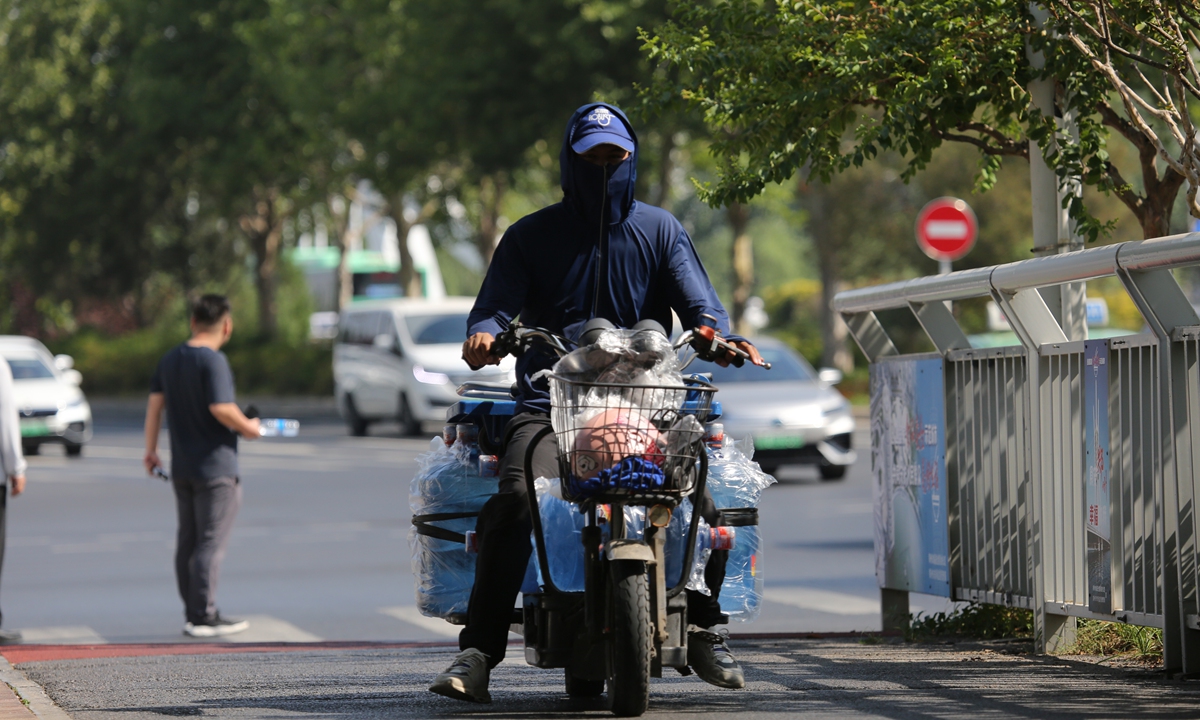
Zhengzhou residents travel amid high temperatures above 40 C in Zhengzhou, Central China's Henan Province, on June 12, 2024.Photo: VCG
Parts of central and northern China have been struck by severe heat waves, which impacted daily life and agriculture.
Experts attribute the direct factors of high temperatures to global warming and atmospheric circulation anomalies, while authorities have taken prompt actions to respond to drought in the country's major crop-producing provinces.
China's National Meteorological Center (NMC) maintained an orange alert, the second highest level, for high temperature on Wednesday, forecasting the scorching temperatures across large regions of northern China until Friday.
The temperature soared to between 40C to 42C in the central part of Hebei Province, the northwestern part of Shandong Province and the middle and northern parts of Henan Province. Both Hebei and Henan maintained the red alert, the highest level, for high temperature on Wednesday.
Experts warned that widespread high temperatures in the northern region were set to continue, with central and southern Hebei and northern Henan being the epicenter of a dense pocket of hot air.
The NMC forecasted that in the following days till June 20, high temperatures will linger across the country's northern regions, with places such as the central and southern part of North China and the majority of Huanghuai region expected to have six to eight days with temperatures exceeding 35C, while places such as Henan are expected to have nine to 10 days of high temperatures.
According to Fu Jiaolan, chief forecaster from the NMC, the joint effect of the high pressure and the clear sky with subsidence of warming has facilitated the development of high temperatures.
This round of high temperatures is the most extensive and intense heat wave that has affected the northern part of China so far this year, with regions such as Hebei, Henan, and Shandong experiencing prolonged high temperatures and extreme daily temperatures, Fu said.
The broader context of global warming and anomalies in atmospheric circulation are direct factors contributing to high-temperature weather, Zheng Zhihai, chief forecaster at China's National Climate Center (NCC), told the Global Times on Wednesday.
According to Zheng, high-temperature weather appeared relatively earlier in China this summer, with more instances of high-temperature events.
Statistics show that the average temperature during this spring in China was 12.3 C, which is 1.4 C higher than the same period in previous years, making it the highest on record since 1961 when complete meteorological records first began in China.
The NCC has forecasted that temperatures across most parts of China in June are expected to be close to or above the average for the same period in previous years. In regions such as North China and the Huanghuai area, temperatures will be higher than usual, with more days of high temperatures compared to the same period in previous years, posing a higher risk of periodic heat waves.
Meanwhile, the continuing high temperatures has intensified drought in one of the country's major crop-producing provinces, Henan on Wednesday issued an orange alert for drought, as 72 national-level meteorological stations in 16 cities in the province monitored the drought situation over 10 consecutive days.
Over coming days, Henan will likely face more severe high-temperature and drought inducing conditions, which are expected to directly affect the progress of summer planting and the growth of crops, according to a report for summer harvest and planting from the Henan Provincial Meteorological Service Center.
The Henan provincial agriculture and rural affairs bureau and related technical departments are closely monitoring soil moisture and crop growth status, providing guidance to farmers on scientific irrigation to ensure the normal growth of planted crops.
In response, Henan has initiated a Level IV emergency response to water shortage and drought disasters on Tuesday to combat the continuous drought that has a great impact on agricultural production. The flood control and drought relief authorities in Henan's Queshan county where haven't seen rainfall for 57 days on Tuesday advocated local residents to conserve water to fight against drought.
In Hebei, where widespread high temperatures have not dissipated since June 8, the high temperatures in the following days will promote the rapid ripening of winter wheat in the northern area of the province. The possible precipitation process may increase soil moisture to some extent, which is conducive to the progress of summer sowing work, according to Dong Hangyu, senior engineer from the agrometeorological department of Henan Institute of Meteorological Sciences.
In terms of the impact of La Nina event on the temperatures during this summer, Zheng said that the influence of La Nina on global and Chinese temperatures varies greatly by region and season. From the current predictions, it is expected that La Nina conditions will not fully develop until late summer, and its impact on this summer's temperatures is expected to be relatively minor.




